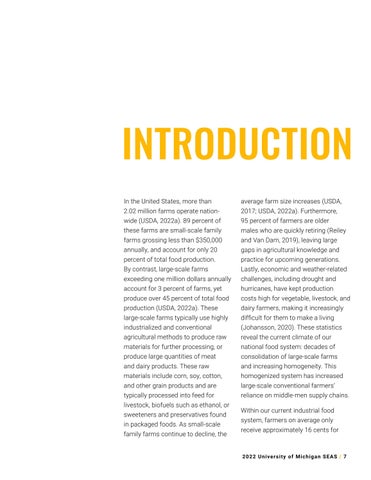INTRODUCTION In the United States, more than
average farm size increases (USDA,
2.02 million farms operate nation-
2017; USDA, 2022a). Furthermore,
wide (USDA, 2022a). 89 percent of
95 percent of farmers are older
these farms are small-scale family
males who are quickly retiring (Reiley
farms grossing less than $350,000
and Van Dam, 2019), leaving large
annually, and account for only 20
gaps in agricultural knowledge and
percent of total food production.
practice for upcoming generations.
By contrast, large-scale farms
Lastly, economic and weather-related
exceeding one million dollars annually
challenges, including drought and
account for 3 percent of farms, yet
hurricanes, have kept production
produce over 45 percent of total food
costs high for vegetable, livestock, and
production (USDA, 2022a). These
dairy farmers, making it increasingly
large-scale farms typically use highly
difficult for them to make a living
industrialized and conventional
(Johansson, 2020). These statistics
agricultural methods to produce raw
reveal the current climate of our
materials for further processing, or
national food system: decades of
produce large quantities of meat
consolidation of large-scale farms
and dairy products. These raw
and increasing homogeneity. This
materials include corn, soy, cotton,
homogenized system has increased
and other grain products and are
large-scale conventional farmers’
typically processed into feed for
reliance on middle-men supply chains.
livestock, biofuels such as ethanol, or sweeteners and preservatives found in packaged foods. As small-scale family farms continue to decline, the
Within our current industrial food system, farmers on average only receive approximately 16 cents for
2 0 2 2 U ni v er si ty of M i c hig an SEA S / 7


